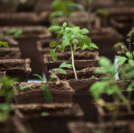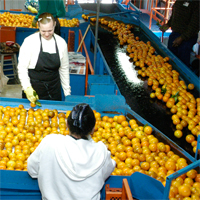What is the Food Safety Modernization Act (FSMA)?
Everyone has a role in ensuring safe food from field to fork. The Food Safety Modernization Act (FSMA) is the first major overhaul of our nation’s food safety practices since 1938, and it includes new regulations for farms that grow fresh produce (fruits and vegetables) and for facilities that process food for people to eat. This means it represents some big changes to our food system – and it is extremely important for the Food and Drug Administration to get these regulations right and implement them in a sensible and transparent manner so that they improve food safety without placing an unfair burden on family farms.
FSMA gives the Food and Drug Administration (FDA) broad new powers to prevent food safety problems, detect and respond to food safety issues, and improve the safety of imported foods. To do so, FSMA authorizes new regulatory requirements for farmers who grow certain kinds of fresh produce, and for certain facilities that process food for people to eat.
The regulations focus on addressing food safety risks from microbial pathogen contamination (e.g., Salmonella, E. coli O157:H7, and Shigella). FSMA does not address food safety risks from genetically engineered crops, pesticide use, or antibiotic resistance.
Specifically, FSMA requires FDA to establish new regulations for:
- Operations that grow, harvest, pack, or hold produce (Produce Safety Rule), and
- Facilities that process food for human consumption (Preventive Controls Rule).
FSMA also authorizes FDA to establish regulations for animal feed processors, food transportation providers, and imported foods. However, our FSMA resources are focused on the Produce Safety Rule and the Preventive Controls Rule.
With the right approach, we will be able to help ensure good food safety practices without placing an unfair burden on family farmers. For a safe and sustainable future, FSMA must allow farmers to use sustainable farming practices, allow local food and farms to grow and thrive, and treat family farms fairly!
Why Does it Matter?
Food safety matters because everybody eats – and everybody has a role in keeping food safe from farm to the table. Done right, these new rules can help make our food safer; done wrong, they run the risk of putting farmers out of business, limit consumer choice, and increase the use of chemicals rather than natural fertilizers, among other problems. That is why NSAC engaged extensively in the rulemaking process, to ensure the voices of sustainable food and farm system advocates and practitioners — from farmers to local food producers to schools to consumers — were heard and considered by FDA. And we were successful!
In fact, FDA heard from so many sustainable agriculture advocates during the initial rulemaking phase, that they took the largely unprecedented step of going back to the drawing board on several critical issues and issuing a revised proposed rule for further public comment. These revisions, and the final rules that followed, are by no means perfect, but they reflect a number of gains thanks to the advocacy of NSAC and our members and allies. And they go a long way toward avoiding some of the unintended adverse consequences for sustainable farming that could have resulted from the original proposals for the Produce Safety Rule and the Preventive Controls Rule.
The risk of foodborne illness — that is, the risk of getting sick or dying from food contaminated with pathogens like E. coli — is largely preventable by good food safety measures applied at every step from farm to fork – from the fields where food is grown to the family dinner table. Examples of good measures include hand washing and keeping foods at the right temperature. However, it’s not as simple as requiring all farms and facilities to meet identical safety requirements. Depending on the complexity of the supply chain, types of food, and the kinds of practices a farm or facility uses, different kinds of farms and facilities face different types of risks when it comes to contamination that could cause illness.
Ultimately, we want to ensure a safe food supply, strong on-farm conservation of natural resources, and thriving family farms and food businesses. With regulations and requirements that are tailored to different types and sizes of operations, we can achieve these objectives.
Where Did FSMA Come From?
Due to a rise in major outbreaks of foodborne illnesses and increasing bioterrorism concerns after 9/11, both Congress and the Obama Administration proposed new food safety measures in 2009 that expanded food safety regulations to the farm level. Previously, food safety regulatory oversight was focused mainly on the processing, food handling, and manufacturing sectors – areas shown to be of highest risk for foodborne pathogen contamination.
In 2009 and 2010, Congress debated a number of food safety proposals that directly and indirectly affected farms and on-farm processing. These proposals extended regulatory authorities to farms and made some on-farm safety standards mandatory. Concurrently, the Obama Administration created an inter-agency Food Safety Working Group through which the Food and Drug Administration and the U.S. Department of Agriculture started adopting new food safety standards and oversight.
Given the potential impacts of these new food safety proposals on sustainable food production, NSAC created a task force and engaged in the legislative debate. NSAC’s priority was to make sure that the new food safety measures worked for sustainable and organic farmers, and for consumers who wanted access to fresh, local food. Due to NSAC’s leadership and the actions of thousands of farmers and concerned consumers, the new food safety law that Congress passed and that President Obama signed – the Food Safety Modernization Act (FSMA) – included the following critical provisions:
- Scale-appropriate regulations: Rejecting a “one-size-fits-all” approach, FSMA includes options for small, mid-sized, and direct-market agricultural operations to comply with equivalent state regulations or modified, scale-appropriate federal regulation.
- Conservation practices: Recognizing that conservation practices have a number of public benefits, FSMA indicates that new regulations should not undermine beneficial on-farm conservation and wildlife practices.
- Organic production: Acknowledging that organic production and food safety go hand-in-hand, FSMA specifies that new regulations must complement – not contradict – strict regulations for certified organic production.
- Value-added processing: Supporting the development of new low-risk processing businesses, FSMA minimizes extra regulations for low-risk processing that is part of value-added production.
- Paperwork reduction: Recognizing the burden on smaller operations, FSMA streamlines and reduces unnecessary paperwork for farmers and small processors.
- Farm identity-preserved: Accepting that identity-preserved marketing has built-in traceability attributes, FSMA allows farm identity-preserved marketing as an option in place of government trace-back controls.
- Training: Supporting the importance of training and capacity building, FSMA authorizes a new competitive grants program to train farmers and processors on food safety.
Once the law was passed, NSAC turned our attention to the implementation phase. First, the rulemaking phase, to ensure that the regulations FDA develops reflected these critical provisions and protections. The second stage of implementation is the development of guidance documents and other materials, practices, and processes that interpret and apply the new requirements. FDA is still in the midst of this aspect of implementation, and simultaneously is setting up the next aspect of implementation: processes for ensuring compliance and enforcement of the rules. NSAC remains committed to ensuring the voices and concerns of the sustainable agriculture community are considered throughout.
What Happens Now?
FDA has started the lengthy process of implementing FSMA. The first stage of implementation is rulemaking: turning the FSMA bill passed by Congress in 2010 into actual rules and regulations that will affect farmers, food businesses, and everyone who eats food. FDA proposed, and then re-proposed, these rules in 2013 and 2014, and NSAC led a campaign that resulted in thousands of comments to FDA on the rules and some major improvements to some of the most troublesome provisions. However, there is still work to do!
FDA finalized the Produce Safety and Preventive Controls Rules in 2015, but there continue to be concerns and challenges to the finalized regulations that are impacting successful implementation of the new requirements (like the agricultural water standard and the farm definition) that FDA has said they will address, as well as provisions (like the manure standard) that have been deferred in order to reach a more sound conclusion. And so although while the Produce Safety and Preventive Controls Rules are technically final, there are still some aspects of these rules that are being worked out, and additional rulemakings may be forthcoming.
Nevertheless, FDA is starting to implement and develop and compliance programs to be able to enforce these new requirements, in many cases in partnership with state departments of health and agriculture. So while there will still be opportunity at the national level to influence aspects of the final rules and how the rules themselves are implemented, significant decisions about how the rules are being implemented — especially as relate to the Produce Safety Rule — are being made at the state level.
Read through our FSMA Resource Center to learn more about what’s in the final Produce Safety and Preventive Controls Rule; what aspects of each rule are still under development; training and educational resources for farmers and food enterprises; what we do and don’t know about how the rules will be implemented; opportunities to engage; and more!
 |
Learn More about the Produce Rule
|
 |
Learn More about the Preventive Controls Rule
|

